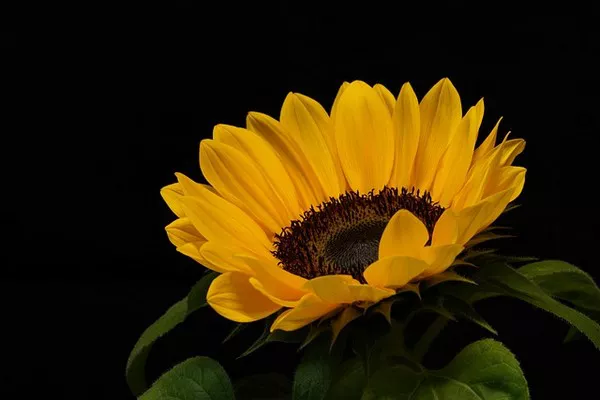Sunflowers, with their bright and cheery disposition, are a favorite among gardeners and nature enthusiasts alike. Whether you’re an experienced gardener or just starting out, growing sunflowers from seeds can be a rewarding and relatively simple endeavor. In this comprehensive guide, we will walk you through the step-by-step process of starting sunflower seeds, from selecting the right seeds to nurturing your sunflowers to their full bloom.
Choosing the Right Sunflower Seeds
The first step in successfully growing sunflowers is selecting the right seeds. Sunflowers come in a variety of sizes, colors, and varieties, so you’ll want to choose the type that best suits your garden and preferences. Here are some key factors to consider:
Variety: Sunflower varieties can be categorized as either ornamental or oilseed. Ornamental sunflowers, such as the popular ‘Helianthus annuus,’ are grown for their stunning flowers and vibrant colors. Oilseed sunflowers, like ‘Helianthus annuus’ var. ‘Mammoth,’ are cultivated for their seeds, which can be harvested for their edible oil. Make sure to choose the variety that aligns with your goals.
Size: Sunflowers come in various sizes, ranging from dwarf varieties that grow to just a few feet tall to towering giants that can reach heights of 12 feet or more. Consider the space you have available and the visual impact you want to create in your garden when choosing the size of your sunflowers.
Color: Sunflowers are known for their bright yellow petals, but there are also varieties available in shades of red, orange, and even bi-colored blooms. Select a color that complements your garden’s aesthetic.
Pollinator-Friendly: If you want to attract pollinators like bees and butterflies to your garden, consider planting sunflower varieties that are known for their appeal to these insects.
Preparing the Soil
Before you sow your sunflower seeds, it’s essential to prepare the soil to provide the best growing conditions for your plants. Here’s how to do it:
Location: Sunflowers thrive in full sun, so choose a spot in your garden that receives at least 6 to 8 hours of direct sunlight each day. Ensure the area is sheltered from strong winds, as tall sunflower stalks can be susceptible to toppling over.
Soil Quality: Sunflowers prefer well-drained soil with a pH level between 6.0 and 7.5. Test your soil and amend it if necessary by adding compost or well-rotted manure to improve its fertility and texture.
Soil Temperature: Sunflowers are warm-weather plants, so wait until the soil temperature has reached at least 50°F (10°C) before planting. This typically occurs in late spring or early summer, depending on your location.
Sowing Sunflower Seeds
Now that your soil is prepared, it’s time to sow your sunflower seeds. Follow these steps for a successful planting:
Seed Spacing: Depending on the variety, space your sunflower seeds 6 to 18 inches apart. Larger varieties require more spacing, so refer to the specific instructions on your seed packet.
Planting Depth: Sunflower seeds should be planted about 1 inch deep in the soil. You can plant them in rows or clusters, depending on your preferred garden design.
Watering: After planting, thoroughly water the soil to settle the seeds and provide initial moisture. Be careful not to overwater, as sunflowers are susceptible to rot in soggy soil.
Caring for Young Sunflower Seedlings
Once your sunflower seeds have germinated and sprouted into young seedlings, they require some care to ensure healthy growth. Here’s what you should do:
Thinning: If you’ve planted multiple seeds close together in clusters, thin out the weakest seedlings, leaving the healthiest ones with adequate spacing. This prevents overcrowding and allows each plant to receive sufficient sunlight and nutrients.
Watering: Sunflower seedlings need consistent moisture, especially during dry spells. Water the plants deeply at the base, ensuring the soil remains evenly moist but not waterlogged. A layer of mulch around the base can help retain soil moisture.
Fertilizing: Sunflowers are not heavy feeders, but a balanced, all-purpose fertilizer can be applied sparingly during the growing season to promote healthy growth. Follow the fertilizer package instructions for application rates.
Supporting Tall Varieties
If you’ve chosen tall sunflower varieties, they may need additional support to prevent them from toppling over under their own weight or in windy conditions. Here’s how to provide proper support:
Staking: Use sturdy stakes or bamboo poles and place them in the ground around the sunflower when it reaches a height of 12 to 18 inches. Secure the sunflower stem to the stake with soft ties or garden twine, leaving enough room for growth.
Tying: As the sunflower continues to grow, periodically check the ties and adjust them as needed to ensure the plant remains upright.
Harvesting Sunflower Seeds
If you’ve grown sunflowers for their seeds, it’s essential to know when and how to harvest them:
Timing: Sunflower seeds are ready for harvest when the flower head begins to droop and the back of the head turns brown. This usually occurs in late summer or early fall, around 120 to 160 days after planting.
Harvesting: To harvest sunflower seeds, cut the flower head from the plant, leaving a few inches of stem attached. Hang the flower heads upside down in a dry, well-ventilated area to cure for a few weeks.
Removing Seeds: Once the flower heads have dried, you can easily remove the seeds by rubbing or shaking them. Be sure to store the seeds in a cool, dry place in an airtight container to keep them fresh.
Conclusion
Growing sunflowers from seeds is a satisfying and enjoyable gardening experience. By selecting the right seeds, preparing the soil, providing proper care to young seedlings, and knowing when to harvest, you can cultivate these cheerful blooms in your garden. Whether you choose ornamental or oilseed varieties, sunflowers are sure to brighten your outdoor space and bring joy to your gardening endeavors. With a little patience and care, you’ll be rewarded with beautiful sunflowers that add a touch of sunshine to your garden.


